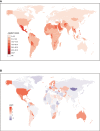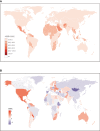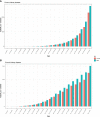Global, regional, and national burden of chronic kidney disease attributable to high fasting plasma glucose from 1990 to 2019: a systematic analysis from the global burden of disease study 2019
- PMID: 38601204
- PMCID: PMC11004380
- DOI: 10.3389/fendo.2024.1379634
Global, regional, and national burden of chronic kidney disease attributable to high fasting plasma glucose from 1990 to 2019: a systematic analysis from the global burden of disease study 2019
Abstract
Purpose: Given the rising prevalence of high fasting plasma glucose (HFPG) over the past three decades, it is crucial to assess its global, national, and regional impact on chronic kidney disease (CKD). This study aims to investigate the burden of CKD attributed to HFPG and its distribution across various levels.
Methods and materials: The data for this research was sourced from the Global Burden of Diseases Study 2019. To estimate the burden of CKD attributed to HFPG, we utilized DisMod-MR 2.1, a Bayesian meta-regression tool. The burden was measured using age-standardized mortality rate (ASMR) and age-standardized disability-adjusted life years (DALYs) rate. Correlation analysis was performed using the Spearman rank order correlation method. Temporal trends were analyzed by estimating the estimated annual percentage change (EAPC).
Results: Globally in 2019, there were a total of 487.97 thousand deaths and 13,093.42 thousand DALYs attributed to CKD attributed to HFPG, which represent a substantial increase of 153.8% and 120%, respectively, compared to 1990. Over the period from 1990 to 2019, the burden of CKD attributable to HFPG increased across all regions, with the highest increases observed in regions with high socio-demographic index (SDI) and middle SDI. Regions with lower SDI exhibited higher ASMR and age-standardized DALYs (ASDR) compared to developed nations at the regional level. Additionally, the EAPC values, which indicate the rate of increase, were significantly higher in these regions compared to developed nations. Notably, high-income North America, belonging to the high SDI regions, experienced the greatest increase in both ASMR and ASDR over the past three decades. Furthermore, throughout the years from 1990 to 2019, males bore a greater burden of CKD attributable to HFPG.
Conclusion: With an increasing population and changing dietary patterns, the burden of CKD attributed to HFPG is expected to worsen. From 1990 to 2019, males and developing regions have experienced a more significant burden. Notably, the EAPC values for both ASMR and ASDR were higher in males and regions with lower SDI (excluding high-income North America). This emphasizes the pressing requirement for effective interventions to reduce the burden of CKD attributable to HFPG.
Keywords: GBD 2019; chronic kidney disease; disability-adjusted life year; high fasting plasma glucose; mortality.
Copyright © 2024 Wei, Ren, Li, Qi, Yang and Li.
Conflict of interest statement
The authors declare that the research was conducted in the absence of any commercial or financial relationships that could be construed as a potential conflict of interest.
Figures






Similar articles
-
Global, regional, and national burden of chronic kidney disease attributable to high sodium intake from 1990 to 2019.Front Nutr. 2023 Mar 2;10:1078371. doi: 10.3389/fnut.2023.1078371. eCollection 2023. Front Nutr. 2023. PMID: 36937353 Free PMC article.
-
The burden of cardiovascular disease attributable to high fasting plasma glucose:Findings from the global burden of disease study 2019.Diabetes Metab Syndr. 2024 May;18(5):103025. doi: 10.1016/j.dsx.2024.103025. Epub 2024 May 7. Diabetes Metab Syndr. 2024. PMID: 38851022
-
Epidemiological and demographic drivers of ischemic stroke attributed to high fasting plasma glucose from 1990 to 2021: findings from the 2021 global burden of disease study.Front Public Health. 2025 May 19;13:1511518. doi: 10.3389/fpubh.2025.1511518. eCollection 2025. Front Public Health. 2025. PMID: 40458089 Free PMC article.
-
The Burden of Cardiovascular Diseases Attributed to Diet High in Sugar-Sweetened Beverages in 204 Countries and Territories From 1990 to 2019.Curr Probl Cardiol. 2024 Jan;49(1 Pt A):102043. doi: 10.1016/j.cpcardiol.2023.102043. Epub 2023 Aug 17. Curr Probl Cardiol. 2024. PMID: 37595857 Review.
-
Global, regional, and national burdens of pancreatic cancer attributable to smoking from 1990 to 2021 and the projections to 2035:a systematic analysis from the global burden of disease study 2021.Front Oncol. 2025 May 30;15:1547029. doi: 10.3389/fonc.2025.1547029. eCollection 2025. Front Oncol. 2025. PMID: 40519307 Free PMC article.
Cited by
-
Global, Regional, and National Temporal Trends in Incidence for Type 2 Diabetes Mellitus Related Chronic Kidney Disease from 1992 to 2021.Diabetes Metab J. 2025 Jul;49(4):848-861. doi: 10.4093/dmj.2024.0593. Epub 2025 Mar 11. Diabetes Metab J. 2025. PMID: 40068620 Free PMC article.
-
Attending an integrated nephrology and diabetology outpatient service can improve diabetic kidney disease treatment: a single-center experience.Acta Diabetol. 2025 Jul;62(7):1057-1064. doi: 10.1007/s00592-024-02423-w. Epub 2025 Feb 21. Acta Diabetol. 2025. PMID: 39982508 Free PMC article.
-
Global, regional, and national burden inequality of chronic kidney disease, 1990-2021: a systematic analysis for the global burden of disease study 2021.Front Med (Lausanne). 2025 Jan 15;11:1501175. doi: 10.3389/fmed.2024.1501175. eCollection 2024. Front Med (Lausanne). 2025. PMID: 39882527 Free PMC article.
-
Gene Editing: An Effective Tool for the Future Treatment of Kidney Disease.J Inflamm Res. 2025 Mar 17;18:4001-4018. doi: 10.2147/JIR.S506760. eCollection 2025. J Inflamm Res. 2025. PMID: 40125088 Free PMC article. Review.
-
New insights in the treatment of DKD: recent advances and future prospects.BMC Nephrol. 2025 Feb 11;26(1):72. doi: 10.1186/s12882-025-03953-3. BMC Nephrol. 2025. PMID: 39934650 Free PMC article. Review.
References
MeSH terms
Substances
LinkOut - more resources
Full Text Sources
Medical
Miscellaneous

